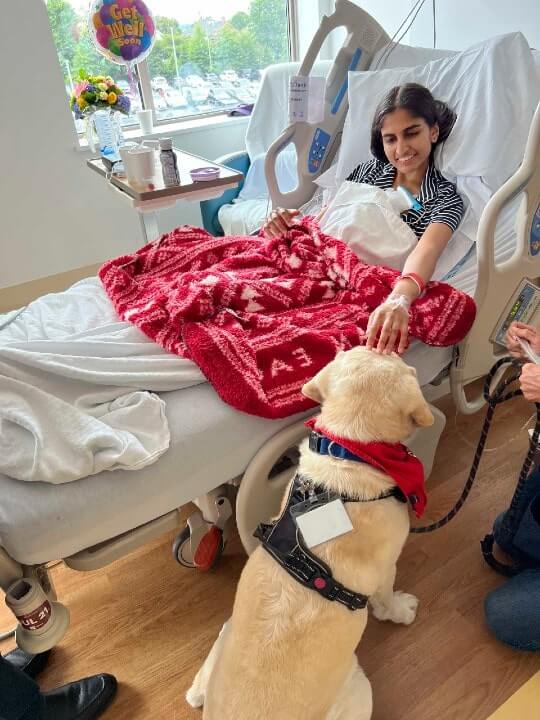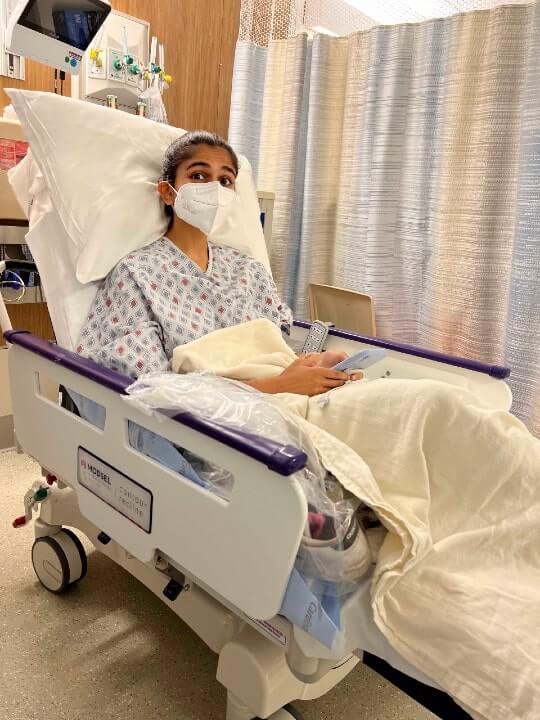Mandira Shashank was like most seniors in college: studying for her classes, hanging out with her friends, and planning for her future. However, as her days in undergrad ticked away, Shashank discovered she had the painful and rare condition of median arcuate ligament syndrome (MALS) that would cloud, but not dim, the final half of her senior year.
Her journey from symptoms to diagnosis was long and winding, as is often the case with MALS, a rare condition. Just before Thanksgiving break, Shashank began feeling nauseated after consuming anything – from meals to small snacks. “I wasn’t eating as much as I normally would. It wasn’t intentional, but my appetite just wasn’t there,” she said. “By December, a few bites of food or even sips of water would cause me to feel nauseous or even vomit.”
As the new year began, pain settled into the upper abdominal area. “It was very sharp and lasted hours after I ate anything,” she recalled. Shashank also began losing weight rapidly. “In the first month, I lost 10 pounds,” she said.
Her journey from symptoms to diagnosis was long and winding, as is often the case with MALS, a rare condition. Just before Thanksgiving break, Shashank began feeling nauseated after consuming anything – from meals to small snacks. “I wasn’t eating as much as I normally would. It wasn’t intentional, but my appetite just wasn’t there,” she said. “By December, a few bites of food or even sips of water would cause me to feel nauseous or even vomit.”
As the new year began, pain settled into the upper abdominal area. “It was very sharp and lasted hours after I ate anything,” she recalled. Shashank also began losing weight rapidly. “In the first month, I lost 10 pounds,” she said.
Shashank, an aspiring physician, juggled the medical school application process with visits to doctors and specialists to determine the cause. She had been to urgent care centers and gastroenterologists multiple times to rule out more common causes such as cancer.
When her CT scans and endoscopy returned normal, some doctors suggested that the pain and weight loss might be due to anxiety or an eating disorder. “Although those are very real concerns, I knew that that wasn’t the case with me,” Shashank said.
When her CT scans and endoscopy returned normal, some doctors suggested that the pain and weight loss might be due to anxiety or an eating disorder. “Although those are very real concerns, I knew that that wasn’t the case with me,” Shashank said.
During winter break Shashank visited a gastroenterologist in New York City and finally felt like she was on the right path. He suggested testing for more uncommon conditions, namely MALS. “He said we had ruled out the horses and now we needed to start looking for some zebras,” she said.
Having read about MALS on her own and even stumbled upon a few videos on TikTok, she was hesitant to consider it as a possibility. “It’s just so rare that I felt like the odds of it being MALS was just super low,” she said.
MALS is diagnosed in about 2 out of every 100,000 patients, according to the National Institutes of Health. The congenital anomaly, meaning it is present at birth, occurs where the diaphragm is too low. This causes the median arcuate ligament to push against the celiac artery, which puts pressure on the nerves surrounding it. That pressure can cause the nerves to become inflamed and send pain signals to the brain. Over time, the inflammation increases, and the nerves are chronically activated.
Having read about MALS on her own and even stumbled upon a few videos on TikTok, she was hesitant to consider it as a possibility. “It’s just so rare that I felt like the odds of it being MALS was just super low,” she said.
MALS is diagnosed in about 2 out of every 100,000 patients, according to the National Institutes of Health. The congenital anomaly, meaning it is present at birth, occurs where the diaphragm is too low. This causes the median arcuate ligament to push against the celiac artery, which puts pressure on the nerves surrounding it. That pressure can cause the nerves to become inflamed and send pain signals to the brain. Over time, the inflammation increases, and the nerves are chronically activated.
Pain, which occurs between the sternum and ribs, can be triggered after eating and drinking and may even spread to the sides, back, and chest. Those with MALS often experience nausea, fatigue, or vomiting after eating, which results in weight loss. By the time Shashank had surgery in the summer, she weighed just 85 pounds.
When testing confirmed a MALS diagnosis, Shashank headed back to college to finish her senior year. “It was definitely very tough because I wasn’t eating a lot and trying to get through medical school interviews, but I had really lovely friends and still got to spend time with the people I really cared about,” she said.
Shashank had planned to have surgery after graduation and met with different surgeons in the New York area. Once she met with Dr. Richard Hsu at Stamford Health, she knew she had found the doctor for her. “He immediately put me at ease,” Shashank said. “He met with my father and me for over an hour first answering all my questions and then all of my dad’s. He knew exactly what was going on and knew what to do, all of which was new to me.”
When testing confirmed a MALS diagnosis, Shashank headed back to college to finish her senior year. “It was definitely very tough because I wasn’t eating a lot and trying to get through medical school interviews, but I had really lovely friends and still got to spend time with the people I really cared about,” she said.
Shashank had planned to have surgery after graduation and met with different surgeons in the New York area. Once she met with Dr. Richard Hsu at Stamford Health, she knew she had found the doctor for her. “He immediately put me at ease,” Shashank said. “He met with my father and me for over an hour first answering all my questions and then all of my dad’s. He knew exactly what was going on and knew what to do, all of which was new to me.”
Having completed the celiac plexus nerve block, which confirmed her as a candidate, Shashank had the surgery in May 2022, about six months after her nausea set in. During the procedure, Hsu resected the median arcuate ligament and removed the celiac plexus nerves.
Shashank recovered in the hospital for about a week and noticed the difference almost immediately. “It was night and day,” she said. “I hadn’t eaten a normal amount of food in so long that I think my stomach wasn’t accustomed to eating so much. The next day or so I got jerk chicken and I remember being pretty nervous about eating it,” she said. “My parents were kind of staring at me like I was about to be in pain, and I just said to them, ‘No, it’s OK. I’m fine.’”
Shashank recovered in the hospital for about a week and noticed the difference almost immediately. “It was night and day,” she said. “I hadn’t eaten a normal amount of food in so long that I think my stomach wasn’t accustomed to eating so much. The next day or so I got jerk chicken and I remember being pretty nervous about eating it,” she said. “My parents were kind of staring at me like I was about to be in pain, and I just said to them, ‘No, it’s OK. I’m fine.’”
Looking back on her experience, she credits Dr. Hsu and the nurses at Stamford Hospital for her recovery. “It was very scary to be recovering from major surgery, but the nurses knew exactly how to help,” she said. “They had my back and were on my side, and that was so comforting.”
Now, Shashank is busy in medical school and grateful for each bite and sip she takes. “I took it for granted for so many years. If you don’t have your health, you can really miss out on a lot, so I’m grateful and lucky that I’m healthy and can eat normally now,” she said.
And while she’s keeping an open mind about what kind of field she’ll focus on, she admits, “My own experience will color what I go into. There was a time when I thought medical school wasn’t going to happen, so I’m grateful that I’m here now and moving forward.”
Now, Shashank is busy in medical school and grateful for each bite and sip she takes. “I took it for granted for so many years. If you don’t have your health, you can really miss out on a lot, so I’m grateful and lucky that I’m healthy and can eat normally now,” she said.
And while she’s keeping an open mind about what kind of field she’ll focus on, she admits, “My own experience will color what I go into. There was a time when I thought medical school wasn’t going to happen, so I’m grateful that I’m here now and moving forward.”




